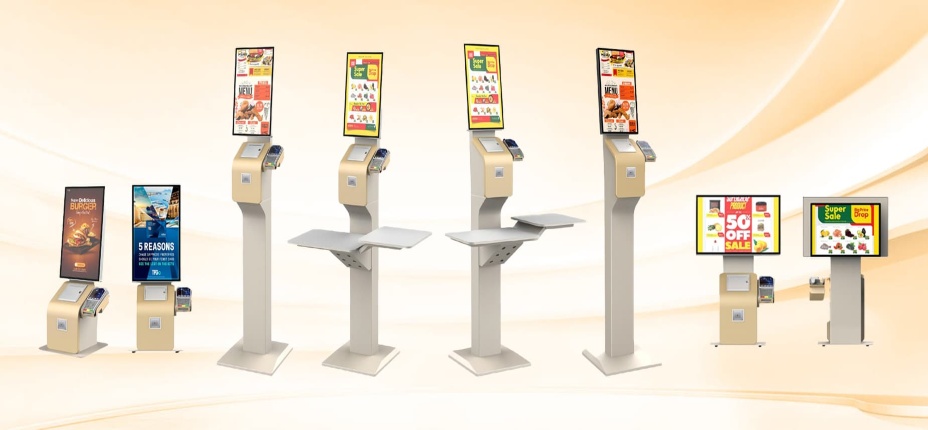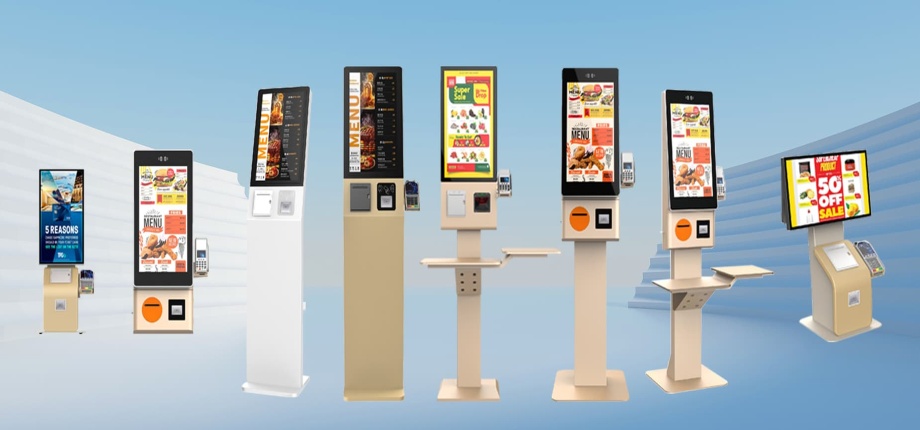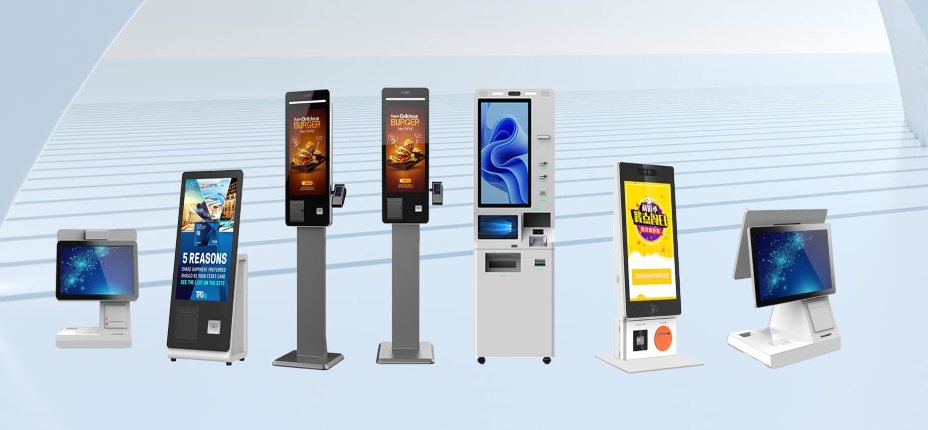Product Details
| Place of Origin: | kiosk manufacturer |
|---|---|
| Brand Name: | Lien |
| Certification: | FCC, CE, ROHS |
| Model Number: | LKS-8389 |
Payment & Shipping Terms
| Min Order: | 10 UNITS |
|---|---|
| Price: | $ |
| Packaging: | Strong Case |
| Delivery Time: | 5-6 weeks |
| Payment Terms: | TT |
| Supply Ability: | 5000 units per month |
Detailed Product Description
Welcome to our Subway Self Order Kiosk homepage! Here, we will provide a comprehensive introduction to our Subway Self Order Kiosk product line. These kiosks are designed to enhance the customer experience and improve operational efficiency, featuring an easy-to-use interface, fast order processing, and support for multiple payment options. Whether it's reducing wait times, improving order accuracy, or enhancing overall customer service, the Subway Self Order Kiosk offers significant benefits for your business. Discover its features, applications, and advantages to better serve your customers.
Subway Self-Order Kiosk: Preview Navigation
Introduction:what is a subway self order kioskOverview of Subway Self-Order Kiosks, highlighting their purpose and key functions. Features of Subway Self Order KioskDetailed breakdown of the kiosk’s technical specs, including display, performance, and payment options. Specifications of subway self order kioskPricing and Cost ConsiderationsInsights into the cost of purchasing and maintaining the kiosks, including expected ROI. Installation and ConfigurationStep-by-step guide on setting up and configuring Subway Self-Order Kiosks. Benefits of Subway Self Order KioskExplanation of how the kiosks improve customer experience, boost operational efficiency, and increase sales. Customization OptionsOverview of design and functional customization possibilities. Maintenance and SupportGuidelines on maintaining and troubleshooting the kiosk, along with available support services. FAQs about subwat self order kioskCommon questions related to Subway Self-Order Kiosks. |
|
Subway Self Order Kiosk is touch-screen interfaces designed to streamline the ordering process in Subway restaurants. Customers can browse the menu, customize their orders, and make payments, all without needing to interact with staff. These kiosks are built for fast, efficient service, reducing wait times and enhancing customer experience. Their user-friendly design ensures that anyone can navigate the menu quickly, while features like contactless payment add convenience for modern users.
High-Resolution Touchscreen Display: A large, high-resolution touchscreen display provides a clear, engaging interface for customers to browse the menu, customize their orders, and interact with the kiosk effortlessly.
Efficient Processing Power: Equipped with a powerful processor (such as Intel i5 or i7), the kiosk ensures quick and reliable performance, allowing for smooth operation and fast processing of customer orders.
Ample Memory and Storage: Typically featuring a minimum of 8GB of RAM and SSD storage (e.g., 256GB), the kiosk supports efficient multitasking, quick data retrieval, and reliable system performance.
NFC and Contactless Payment Options: Integrated NFC technology enables customers to make secure and speedy contactless payments using mobile wallets or contactless credit cards, enhancing the overall transaction experience.
Customizable User Interface: The kiosk software can be tailored to match the Subway brand’s visual identity, including custom menus, promotional displays, and language options to meet diverse customer needs.
User-Friendly Design: Designed with an intuitive touch interface and clear navigation options, the kiosk ensures a seamless customer experience, reducing confusion and streamlining the ordering process.
Durable and Easy to Clean: Constructed from durable materials, the kiosk is built to withstand high-traffic use while being easy to clean and maintain, ensuring long-term reliability and hygiene.

| Specification | Details |
|---|---|
| Display Size | Typically 15 to 21.5 inches |
| Display Type | HD LCD or LED Touchscreen |
| Resolution | 1920 x 1080 pixels (Full HD) |
| Processor | Intel Core i5 or i7 |
| RAM | 8GB to 16GB |
| Storage | 128GB to 256GB SSD |
| Operating System | Windows 10 IoT, Linux-based OS, or custom OS |
| Touchscreen Technology | Capacitive, multi-touch |
| Payment Options | NFC, EMV, RFID, and cash payments |
| Connectivity | Ethernet, Wi-Fi, optional 4G/5G |
| Networking | TCP/IP, VPN support |
| Printer Integration | Integrated or optional external receipt printer |
| Dimensions (W x H x D) | Varies, typically around 20-30 x 40-50 x 10-20 inches |
| Weight | 40 to 80 lbs (18 to 36 kg) |
| Power Requirements | 110-240V AC, 50/60Hz |
| Housing Material | Metal, plastic, or a combination of both |
| Durability | Industrial-grade, for high-traffic areas |
| Accessibility Features | ADA compliant, adjustable height and interface |
| Customization Options | Branding, additional hardware, software features |
| Warranty | 1-year standard, with options for extended coverage |
| Maintenance | Remote diagnostics, software updates, and on-site service options |
Display Size: Ranges from 15 to 21.5 inches for varying visibility and interaction needs.
Processor: Models range from Intel Celeron to Intel i7, ensuring performance aligns with usage requirements.
RAM: Options from 4GB to 16GB for handling different levels of multitasking and application demands.
Storage: SSD options from 128GB to 1TB for quick data access and storage capacity.
OS: Windows 10 IoT for compatibility with various software solutions.
Touchscreen: Capacitive multi-touch technology for responsive user interactions.
Payment Options: Includes NFC, credit/debit cards, and mobile payments for flexible transaction methods.
Connectivity: Options for Ethernet and Wi-Fi to ensure network connectivity.
Durability Rating: IP54 to IP65 for protection against dust and water.
Mounting Options: Includes floor-standing and wall-mounted configurations.
Warranty: Ranges from 1 to 3 years, depending on the model.
Customization Options: Vary from basic branding to full custom features, including UI and menu modifications.
NFC PaymentsThe kiosk supports Near Field Communication (NFC), allowing for contactless payments using mobile wallets such as Apple Pay, Google Pay, and other NFC-enabled cards. This speeds up the transaction process and enhances convenience for customers who prefer contactless payment methods. Credit/Debit Card PaymentsThe kiosk is equipped with card readers that accept both credit and debit cards, including chip-enabled (EMV) and magnetic stripe cards. This offers customers a reliable and familiar method of payment. Mobile Payment IntegrationWith built-in support for mobile payments, the kiosk allows customers to use apps like PayPal, Venmo, or any proprietary mobile payment system that supports QR code scanning or NFC technology. |
|
| QR Code PaymentsSubway kiosks can be integrated with QR code payment systems, allowing users to scan a code from their mobile device to complete a transaction seamlessly. Prepaid Card PaymentsCustomers can use Subway gift cards or other prepaid cards at the self-order kiosks, making it convenient for those with store credit or promotional cards. Loyalty Programs IntegrationThe kiosk system can integrate with Subway’s loyalty program, allowing customers to redeem points or use stored payment methods associated with their loyalty accounts. Cashless TransactionsThe kiosk is designed for cashless environments, focusing on electronic transactions, which simplifies operations and reduces the need for handling physical cash. |
The price of a Subway Self-Order Kiosk typically ranges from $5,000 to $10,000, depending on customization and additional features. This base cost covers hardware, basic software, and initial setup.
| Model | Display Size | Processor | RAM | Storage | Payment Options | Price Range (USD) |
|---|---|---|---|---|---|---|
| Basic Subway Kiosk | 15-inch | Intel i5 | 8GB | 128GB SSD | Credit/Debit Card, NFC | $3,000 - $4,000 |
| Mid-Range Subway Kiosk | 21.5-inch | Intel i7 | 16GB | 256GB SSD | NFC, QR Code, Mobile Payments | $5,000 - $6,500 |
| Advanced Subway Kiosk | 27-inch | Intel i7 | 16GB | 512GB SSD | NFC, Mobile Payments, Loyalty Programs | $7,000 - $8,500 |
| Outdoor Subway Kiosk | 21.5-inch | Intel i7 | 16GB | 256GB SSD | NFC, QR Code, Mobile Payments | $8,000 - $10,000 |
| Custom Subway Kiosk with Extended Features | 27-inch | Intel i9 | 32GB | 1TB SSD | All Payment Methods | $10,000 - $12,000 |
Additional Costs of subway self order kioskThere are additional expenses to consider, such as installation fees, which range from $500 to $1,500. Maintenance and software updates may also incur ongoing costs. You should budget for potential repairs and replacements of components like touch screens, which can cost several hundred dollars. Cost-Benefit Analysis of subway self order kioskInvesting in Subway Self-Order Kiosks can lead to a fast return on investment (ROI), particularly by reducing labor costs and increasing sales through faster service and upselling opportunities. On average, kiosks can pay for themselves within 12 to 18 months, depending on the location and volume of customer traffic. |
|
Installing a Subway Self-Order Kiosk is straightforward, typically taking one to two days. First, technicians will mount the kiosk in the designated area. The power and data connections are then established, followed by software setup. Proper alignment with the restaurant’s POS system is crucial to ensure seamless transaction processing.
Site Preparation: Ensure the location for the Subway self-order kiosk is well-prepared with adequate space, power supply, and internet connectivity.
Unpacking and Inspection: Carefully unpack the kiosk, inspect all components, and check for any shipping damage or missing parts before installation begins.
Mounting the Kiosk: Secure the kiosk to its designated mounting point, whether it's floor-mounted or wall-mounted, ensuring it's stable and accessible for customers.
Connecting Power and Internet: Plug in the kiosk to the power supply and connect to the local network via Ethernet or Wi-Fi, ensuring a stable internet connection for transaction processing.
Software Installation and Setup: Install and configure the necessary software, including payment applications, menu displays, and order management systems specific to Subway’s requirements.
Payment System Integration: Integrate the kiosk with various payment methods such as NFC, credit cards, and mobile payments, ensuring compatibility with Subway's POS systems.
Testing and Calibration: Run tests on the system to ensure all components, such as the touchscreen, payment processing, and software, function correctly. Calibrate the display and adjust settings as needed before going live.
The next step involves configuring the software to match the Subway restaurant’s specific menu and pricing. This includes uploading menu items, setting up promotions, and configuring payment options. Restaurant managers can access the system to make changes as needed. Configuration generally takes an additional half-day.
The entire installation and configuration process typically takes two to three days, depending on the complexity of the customization and the size of the restaurant.

Increased Order Accuracy: Subway self-order kiosks reduce human error by allowing customers to input their orders directly, ensuring accuracy and minimizing order mistakes.
Faster Service: With self-order kiosks, customers can quickly place their orders, reducing wait times and increasing the speed of service during peak hours.
Enhanced Customer Experience: The user-friendly interface allows customers to customize their orders with ease, providing a personalized and convenient dining experience.
Higher Order Value: Self-order kiosks can suggest add-ons or upsell items, often leading to higher average order values compared to traditional ordering methods.
Labor Cost Savings: By automating the ordering process, Subway restaurants can reallocate staff to other essential tasks, reducing the need for additional personnel.
Contactless Payment Options: Subway kiosks support various payment methods, including NFC and mobile payments, enhancing convenience and ensuring a safe, contactless transaction process.
Real-Time Menu Updates: The kiosks allow for easy and instant menu updates, promotions, or limited-time offers, ensuring accurate information is always displayed to customers.
Design CustomizationSubway Self-Order Kiosks can be customized to fit the restaurant’s branding, including color schemes, logos, and design layouts. Restaurants can choose different finishes to match their decor and create a cohesive look. | Functional CustomizationBeyond aesthetics, Subway Self-Order Kiosks offer a range of functional customizations. Restaurants can adjust menu layouts, include promotional offers, and even change the language options to better serve their customer base. Additional hardware, like larger screens or card readers, can also be incorporated to meet specific needs. |
| Design Customization | Functional Customization |
|---|---|
| 1. Display Size Options: Choose from 15", 21.5", or 32" screens. | 1. Payment Integration: Support for NFC, credit card, and mobile payments. |
| 2. Color Customization: Customize the kiosk's color to match brand aesthetics. | 2. Menu Customization: Easily update or modify the digital menu interface. |
| 3. Material Options: Options for metal, aluminum, or plastic enclosures. | 3. Loyalty Program Integration: Connect kiosks to existing loyalty systems. |
| 4. Logo Placement: Add branded logos to the kiosk for personalization. | 4. Multi-Language Support: Provide a multi-language interface for diverse customers. |
| 5. Screen Orientation: Select portrait or landscape mode for display. | 5. Order Customization: Allow customers to fully customize their orders. |
| 6. Kiosk Size: Customize the height and footprint to fit your restaurant space. | 6. Backend Reporting: Integrate with reporting systems for real-time data. |
| 7. Touchscreen Type: Options for capacitive or resistive touchscreen. | 7. Self-Service Checkout: Allow customers to complete orders without staff assistance. |

Regular MaintenanceMaintaining a Subway Self-Order Kiosk is crucial for ensuring consistent and efficient operation. Daily maintenance should include cleaning the touchscreen with a non-abrasive, microfiber cloth to remove fingerprints and dirt, ensuring that the display remains clear and responsive. It’s also important to check the card readers, printers, and payment terminals for any blockages or debris that could affect performance. Hardware components, such as internal wiring and connections, should be inspected weekly to prevent issues like loose cables or improper connections. Monthly inspections by trained technicians are recommended to identify potential problems early, including software updates and hardware wear and tear. A comprehensive maintenance log should be kept to track these actions, ensuring the kiosk operates smoothly and minimizing the risk of unexpected downtime. | TroubleshootingTroubleshooting common issues in the Subway Self-Order Kiosk can often be handled with a straightforward reset, addressing problems like screen calibration errors or temporary software glitches. The kiosk is designed with user-friendly diagnostics that allow operators to quickly identify and resolve minor issues on-site. For more complex problems, Subway provides remote troubleshooting services. This enables technicians to access the system via an online platform, where they can diagnose and resolve issues without needing to visit the location physically. This can save valuable time and reduce downtime for the kiosk, keeping operations running efficiently. Additionally, on-screen prompts guide users through basic troubleshooting steps for common errors, making it easier to restore functionality quickly. |
Customer SupportSubway offers comprehensive customer support for its self-order kiosks, ensuring that any operational issues are addressed promptly. Their 24/7 customer service is always available, allowing restaurant operators to get assistance at any time. Remote monitoring services enable Subway's technical team to keep an eye on the kiosk's performance and proactively address issues before they affect the customer experience. On-site technical support is available when necessary, ensuring that hardware issues are resolved efficiently. Regular software updates are provided as part of the support package, improving the kiosk's functionality, user interface, and security. This ongoing support ensures that the kiosks continue to meet evolving business needs and deliver a smooth ordering experience for customers. | |
The price for a Subway self-order kiosk typically ranges between $10,000 and $15,000, depending on customization options and hardware specifications.
It allows customers to place orders quickly and accurately, reducing wait times and ensuring efficient order processing, leading to a better overall experience.
Yes, it supports a variety of payment methods, including credit/debit cards, mobile payments (NFC), and cash, depending on the customization options selected.
Subway kiosks come pre-installed with specialized POS integration software designed to streamline order management and ensure compatibility with existing systems.
Installation generally takes 2-3 days, including hardware setup, software configuration, and testing to ensure proper functionality before the kiosk goes live.
Yes, Subway self-order kiosks are designed to comply with ADA standards, ensuring accessibility for all customers, including those with disabilities.
Regular maintenance includes daily cleaning, monthly hardware inspections, and software updates to ensure optimal performance and prevent potential issues.
Yes, Subway offers design customization options to match the restaurant's branding, along with functional customizations such as integrated loyalty programs and promotional displays.
Subway Self-Order Kiosks are an innovative solution for businesses looking to streamline operations and improve customer experience. With customizable options, powerful performance, and efficient payment features, they offer high ROI for Subway franchises. Whether you're considering adding kiosks to your restaurant or want to learn more about their benefits, our team is ready to help you make an informed decision. Contact us today to get started!